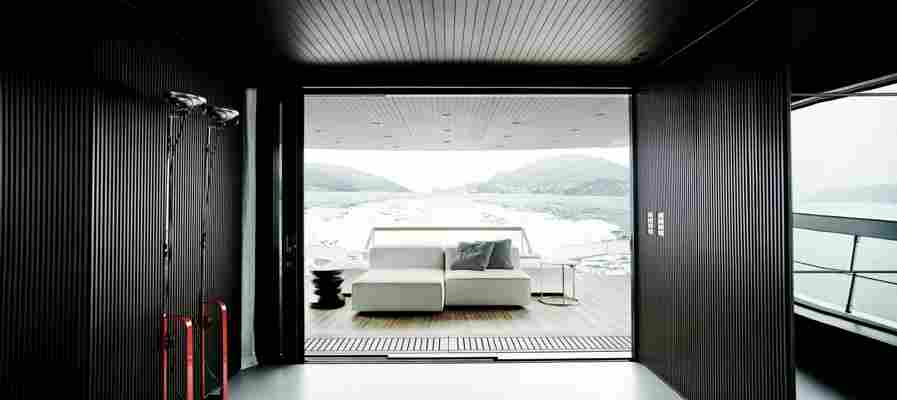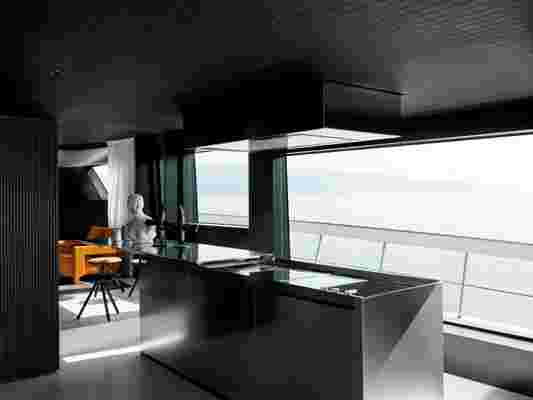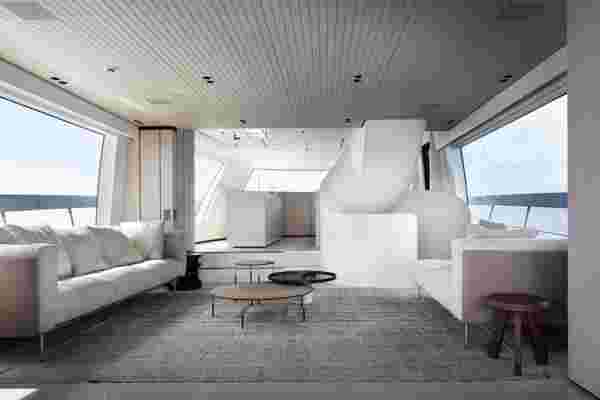May 03,2022
A Yacht Tailor-Made for the Design Aficionados of Tomorrow
by David Stewart
“Normally old boats are designed with many small spaces, because they had this idea that it was to be functional—I never understood why,” says the architect and designer Piero Lissoni, the recently appointed artistic director of Sanlorenzo Yachts. “You have to follow beauty, you have to be sensual. For me, functionality was like a bad word.”
Lissoni—a longtime darling of the design world, particularly in his native Italy, where he has led creative teams for companies ranging from Kartell and Knoll to Boffi and Lema—is gazing at a photo of a recent project for the shipbuilder. The model in question, dubbed the SX88, is a cornerstone of the company’s new crossover range, also comprising the Lissoni-designed SX76. Smaller, more energy efficient, and easier to use than the “superyachts” (ships that exceed 150 feet) historically favored by Sanlorenzo and its competitors, the line was borne of necessity and market cunning.

A view from the SX88 salon toward the rear deck. Lissoni's interiors are characterized by ebonized walls, FLOS lighting, and expansive living and entertaining spaces.
“When you have a downturn like we did in 2008 and 2012—the luxury good is really cut to the neck, because of course you don’t need it,” says Massimo Perotti, the impeccably besuited chairman and CEO of Sanlorenzo, who’s just arrived in Miami, en route to China, to mark the firm’s ongoing partnership with Art Basel Miami Beach. “In a crisis, you have less work to do, so your mind starts to think about what’s needed,” he says, looking back. “Less show-off, more sobriety.”

The open kitchen on the SX88—an industry first for a yacht this size—features a Boffi kitchen. "We had to invent [the hood] coming down from the ceiling," comments Perotti.
Though to call either the SX88 (whose number indicates the vessel’s length in feet), or its slightly smaller sibling, the SX76, simple or sober would be a mischaracterization. While the engines are somewhat downsized—the SX88, which starts at around $6.5 million, has a top cruising speed of just 23 knots—and the salon levels have been opened up to create a more open, egalitarian plan, the custom yachts’ design is unmistakably first-class. Rehearsing the details of one recent commission, Lissoni points out ebonized walls in the main living space with floor-to-ceiling windows, an Eero Saarinen dining table, Mogens Koch chairs, stainless steel galley by Boffi, and Toio lamps by FLOS. On the new SX76, which starts at $5.3 million with a top cruising speed of 22 knots, the space-saving central staircase is as sculptural as it is efficient, leading to an open lounge area on the lower level. It's where a dark, narrow corridor would be found on most other boats of this size.

On the SX76, Lissoni conserved space and increased natural-light flow in the interiors by creating a single, sculptural stairwell that leads from the salon, pictured here, up to the flybridge and down to the cabins.
But knocking down so many traditional walls—literally and figuratively—did not come so easily for the 60-year-old firm. “He forced me to design the salon like a loft, a totally open space,” comments Perotti, laughing incredulously. Lissoni cuts in, smiling, “In the end, when you are on the boat, you are not there for professional issues—you are there because you enjoy it.” He continues, “Why wouldn’t you want the space, the light, and the sea? So I convinced the victims”—nodding at Perotti—“to follow me.”
Apparently the company’s willingness to modernize has been well received, leading to a revenue increase from about $45 million in 2005 to nearly $341 million in 2017. To mark the firm’s growth, Sanlorenzo is reinvesting in its physical plant, including some $68 million going toward shipyards in La Spezia, Ameglia, and Massa, along the northwest coast of Italy. Lissoni is overseeing the redesign of the three sites, alongside far smaller components of the company’s aesthetic language—new stationery, signage, uniforms, and even events. Lissoni art directed its 60th-anniversary party this year, where Andrea Bocelli performed for 600 guests—largely current and prospective owners—who were given high-end versions of the one-piece shipyard workers’ outfits to wear at the celebration.
The flying bridge on both vessels can be open or sealed off, depending on the occupants' preference. "Most customers like to be outside during the day and inside during the night," says Perotti. "You always have a feeling to be connected to the sea."
Asked about this overt, unexpected connection between the shipbuilder’s industrial backbone and design-forward yachts—ones fussed over by discerning collectors for their seamless, stylish sensibility—Lissoni doesn’t hesitate. “One of the most important things to understand is the sophisticated connection between the factory, design, and art,” he says. “The discussion we have is not to build the most beautiful boat in the world—it’s to build credibility.”
RELATED: The Most Elegant Classic Yachts in the World Are Gearing Up for an Epic Championship






